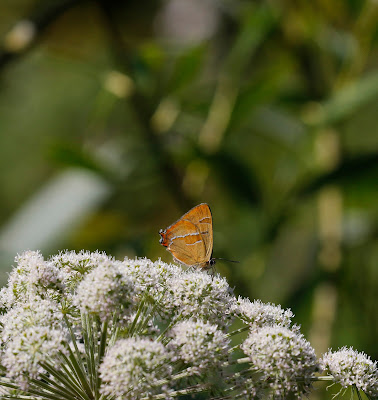I got to the ride at around ten this morning. A grass ride that forms part of a much longer ancient bridleway, its narrow confines bordered for its three hundred or so metres by oak trees, hawthorn and blackthorn, from under which spills out a rampant profusion of late summer vegetation. Greater Willowherb and Wild Angelica stood proud, at almost head height, a mess of pink and white flowers respectively. Frothy cream heads of Meadow Sweet and the pale mauve busbys of Water Mint betrayed the hidden dampness of the ride, while brambles scrambled up into the hawthorns and Greater Bindweed wound its sinuous course through the tangled vegetation to point inverted trumpets of dazzling white to the sky.
The air in the ride was undisturbed, as the width of the ride is narrow enough to exclude the wind and when the sun began to penetrate the ride it became hot, the air warm and soporific.Today I had the ride to myself but often in this time of transition from July to August it can become populated by visitors come to see its annual hidden secret of Brown Hairstreaks.
These are the last of our five native hairstreaks to emerge and to my mind are the most attractive.They are uncommon and need some effort to find but usually one or two descend from the treetops here to nectar on the angelica or the occasional thistle head. The tiny triangle of closed wings, replicating a miniature yacht crossing a convex ocean of white angelica florets.The undersides of the hairstreak's wings are burnt orange with irregular darker bands across both wings and of course an irregular white line, the iconic 'hairstreak' that gives rise to half its name.
I wandered the bounds of the ride and found no hairstreak so stood, as one must do, to await the possible arrival of one. It is impossible to predict their behaviour. All one can know is that sooner or later, on a sunny day one or more will eventually descend but much patience is required as it can be at any hour from mid morning to mid afternoon. Standing silent, still and in contemplative mood I became aware of the aggregate hum of many insect wings combining to bring an insect tinnutus to my hearing but after a while, just like tinnutus it is so constant you just do not register it. Quiet, secretive bird sounds came from within the deep recesses of the trees and bushes. A quiet tack tack of a Blackcap or the plaintive hoooeet of a Chiffchaff or Willow Warbler.
I moved position, a few metres, to where I had seen a hairstreak just two days ago and as if by pre-ordainment there was a Brown Hairstreak nectaring on the very same angelica head. Maybe it was the same hairstreak, maybe not. Both were males, that is true, but I feel it is likely they were different individuals attracted to the same nectar laden flower head.
I luxuriated in the quiet of the ride, a balm, a benificence, while standing no more than two feet from the insect as it toured the various florets probing each miniscule flower. Other insects were also attracted to the nectar rich angelica, hoverflies and bees mainly, that busily barged into the butterfly but were rebuffed by an impatient, irritable flick of delicate wings
For a full forty minutes the butterfly fed, confining itself to an area no more than a few inches of flowerhead before it flew to settle on a leaf, as if to shade itself from the midday heat. It moved to a nettle and slowly opened its wings to reveal no orange markings on the uppersides, thus confirming it was a male.
Seconds later it flew, flickering in the sun, rising upwards into the hawthorn tops and was gone.


















No comments:
Post a Comment